Report: Business Decision Analytics at Tesco (Organizational Analysis)
VerifiedAdded on 2022/10/12
|6
|1033
|473
Report
AI Summary
This report provides an in-depth analysis of Tesco's business decision analytics, focusing on the application of bounded rationality within its organizational framework. It examines the company's vision, values, and organizational structure, highlighting the hierarchical system and communication channels. The research methodology involved evaluating relevant resources and case studies to understand decision-making processes. The report explores how Tesco integrates organizational theories like contingency and bureaucratic theory to improve decision-making, considering factors such as cognitive limitations, emotions, and time constraints. It also emphasizes the importance of ethics and diversity, discussing how these elements positively impact teamwork and decision-making. The conclusion reflects on Tesco's effective management of people and resources, the embrace of organizational theory, and the significance of effective decision-making within the company's operations. The report uses different communication channels like memos to facilitate effective communication between employees. References to academic sources are also provided.
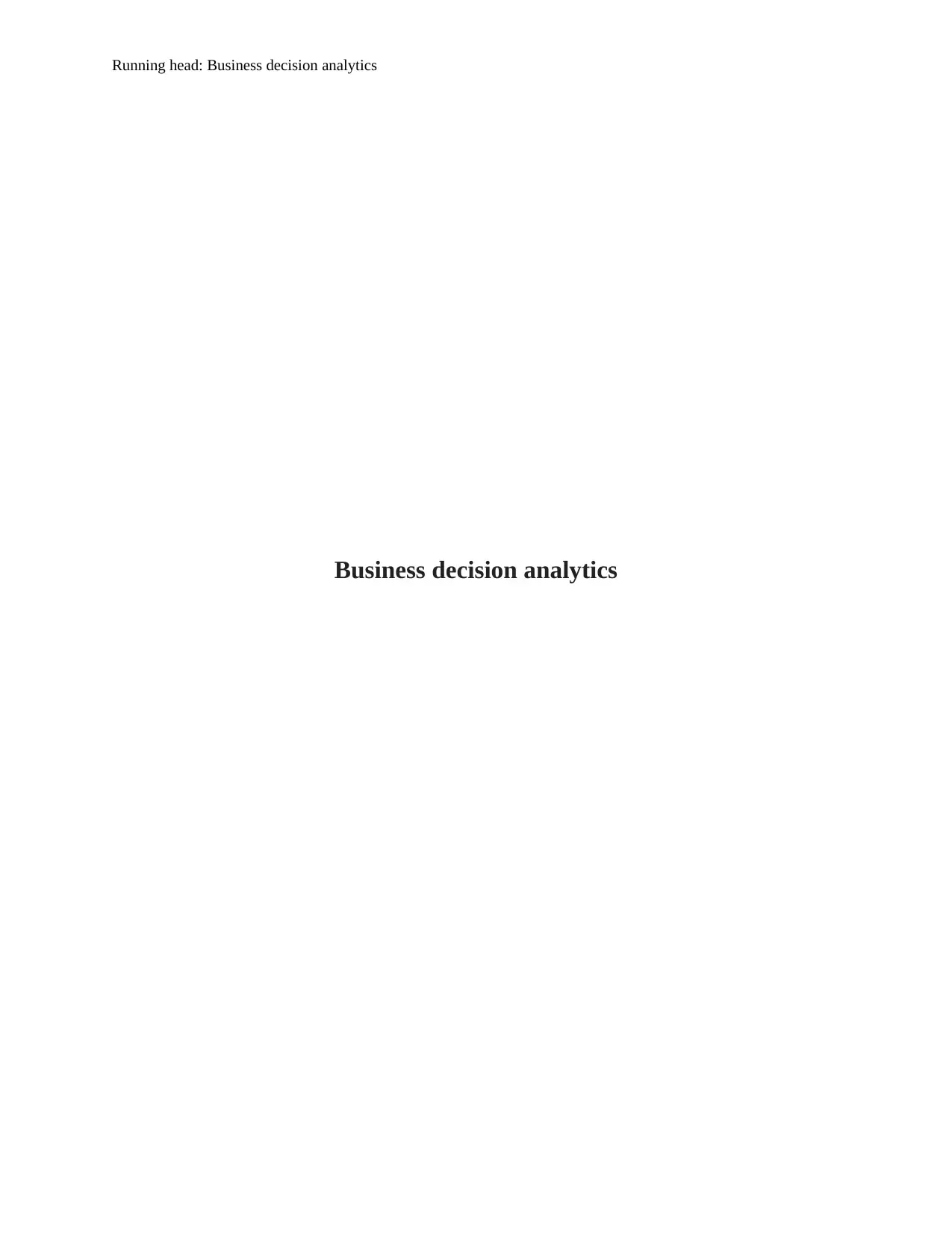
Running head: Business decision analytics
Business decision analytics
Business decision analytics
Paraphrase This Document
Need a fresh take? Get an instant paraphrase of this document with our AI Paraphraser
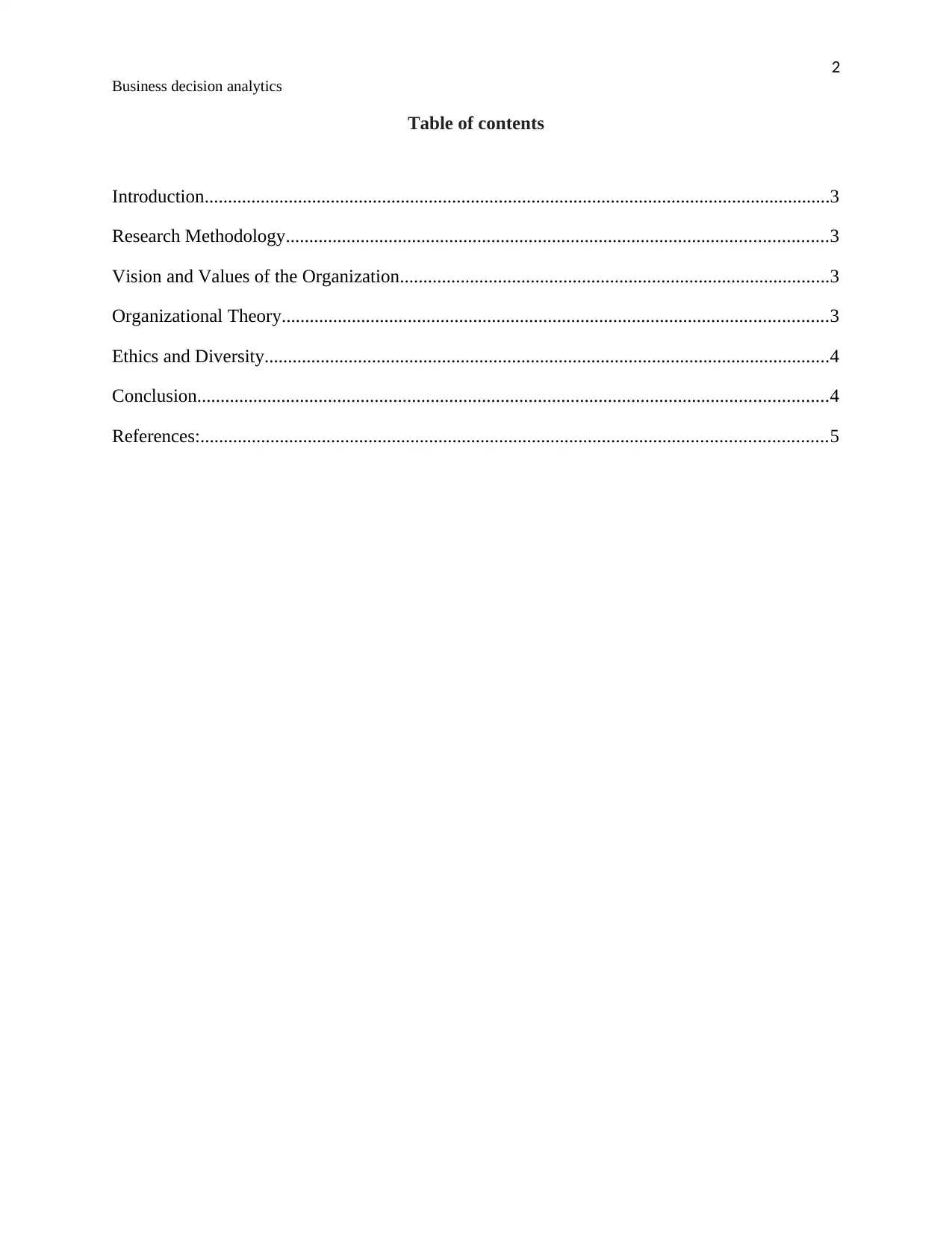
2
Business decision analytics
Table of contents
Introduction......................................................................................................................................3
Research Methodology....................................................................................................................3
Vision and Values of the Organization............................................................................................3
Organizational Theory.....................................................................................................................3
Ethics and Diversity.........................................................................................................................4
Conclusion.......................................................................................................................................4
References:......................................................................................................................................5
Business decision analytics
Table of contents
Introduction......................................................................................................................................3
Research Methodology....................................................................................................................3
Vision and Values of the Organization............................................................................................3
Organizational Theory.....................................................................................................................3
Ethics and Diversity.........................................................................................................................4
Conclusion.......................................................................................................................................4
References:......................................................................................................................................5
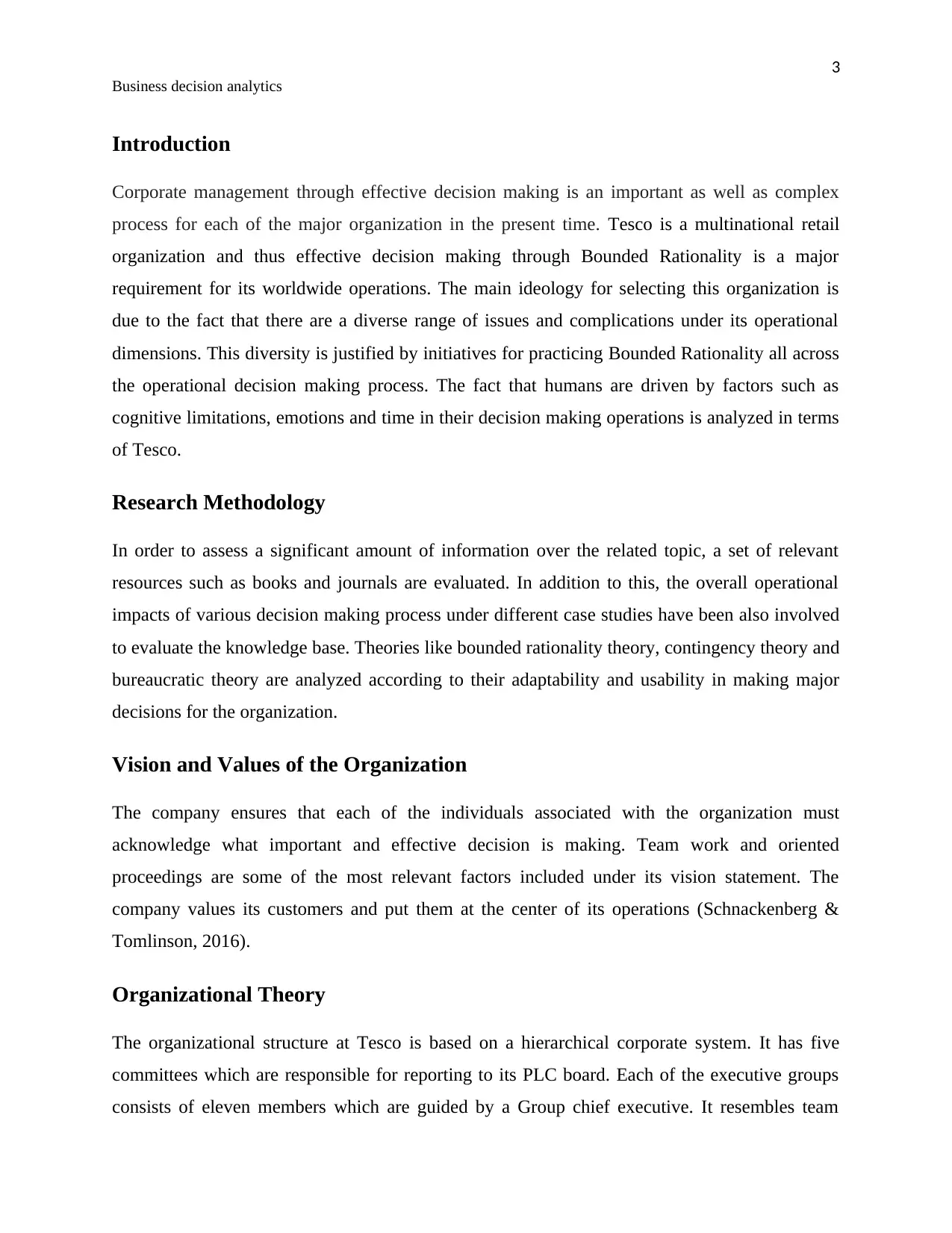
3
Business decision analytics
Introduction
Corporate management through effective decision making is an important as well as complex
process for each of the major organization in the present time. Tesco is a multinational retail
organization and thus effective decision making through Bounded Rationality is a major
requirement for its worldwide operations. The main ideology for selecting this organization is
due to the fact that there are a diverse range of issues and complications under its operational
dimensions. This diversity is justified by initiatives for practicing Bounded Rationality all across
the operational decision making process. The fact that humans are driven by factors such as
cognitive limitations, emotions and time in their decision making operations is analyzed in terms
of Tesco.
Research Methodology
In order to assess a significant amount of information over the related topic, a set of relevant
resources such as books and journals are evaluated. In addition to this, the overall operational
impacts of various decision making process under different case studies have been also involved
to evaluate the knowledge base. Theories like bounded rationality theory, contingency theory and
bureaucratic theory are analyzed according to their adaptability and usability in making major
decisions for the organization.
Vision and Values of the Organization
The company ensures that each of the individuals associated with the organization must
acknowledge what important and effective decision is making. Team work and oriented
proceedings are some of the most relevant factors included under its vision statement. The
company values its customers and put them at the center of its operations (Schnackenberg &
Tomlinson, 2016).
Organizational Theory
The organizational structure at Tesco is based on a hierarchical corporate system. It has five
committees which are responsible for reporting to its PLC board. Each of the executive groups
consists of eleven members which are guided by a Group chief executive. It resembles team
Business decision analytics
Introduction
Corporate management through effective decision making is an important as well as complex
process for each of the major organization in the present time. Tesco is a multinational retail
organization and thus effective decision making through Bounded Rationality is a major
requirement for its worldwide operations. The main ideology for selecting this organization is
due to the fact that there are a diverse range of issues and complications under its operational
dimensions. This diversity is justified by initiatives for practicing Bounded Rationality all across
the operational decision making process. The fact that humans are driven by factors such as
cognitive limitations, emotions and time in their decision making operations is analyzed in terms
of Tesco.
Research Methodology
In order to assess a significant amount of information over the related topic, a set of relevant
resources such as books and journals are evaluated. In addition to this, the overall operational
impacts of various decision making process under different case studies have been also involved
to evaluate the knowledge base. Theories like bounded rationality theory, contingency theory and
bureaucratic theory are analyzed according to their adaptability and usability in making major
decisions for the organization.
Vision and Values of the Organization
The company ensures that each of the individuals associated with the organization must
acknowledge what important and effective decision is making. Team work and oriented
proceedings are some of the most relevant factors included under its vision statement. The
company values its customers and put them at the center of its operations (Schnackenberg &
Tomlinson, 2016).
Organizational Theory
The organizational structure at Tesco is based on a hierarchical corporate system. It has five
committees which are responsible for reporting to its PLC board. Each of the executive groups
consists of eleven members which are guided by a Group chief executive. It resembles team
⊘ This is a preview!⊘
Do you want full access?
Subscribe today to unlock all pages.

Trusted by 1+ million students worldwide
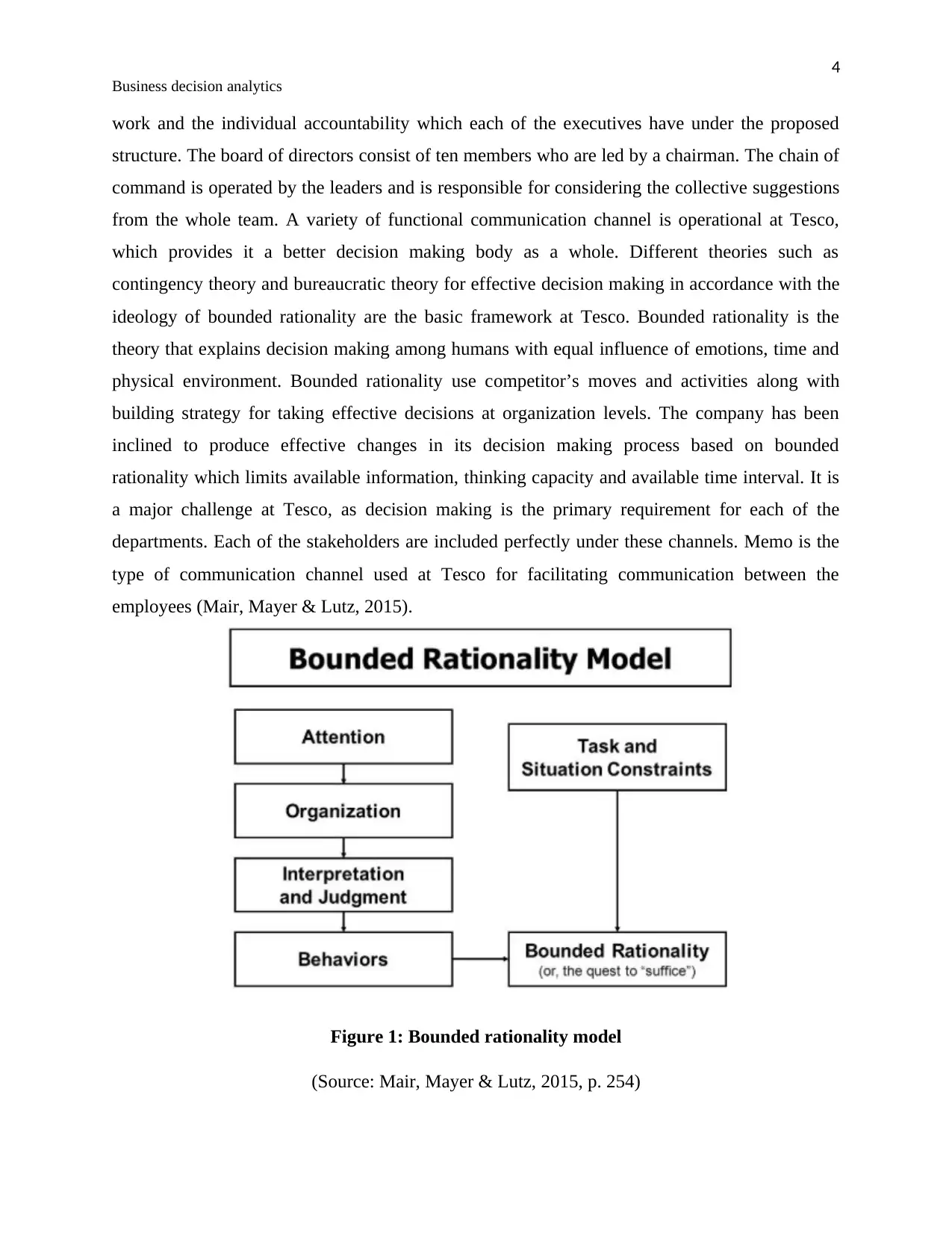
4
Business decision analytics
work and the individual accountability which each of the executives have under the proposed
structure. The board of directors consist of ten members who are led by a chairman. The chain of
command is operated by the leaders and is responsible for considering the collective suggestions
from the whole team. A variety of functional communication channel is operational at Tesco,
which provides it a better decision making body as a whole. Different theories such as
contingency theory and bureaucratic theory for effective decision making in accordance with the
ideology of bounded rationality are the basic framework at Tesco. Bounded rationality is the
theory that explains decision making among humans with equal influence of emotions, time and
physical environment. Bounded rationality use competitor’s moves and activities along with
building strategy for taking effective decisions at organization levels. The company has been
inclined to produce effective changes in its decision making process based on bounded
rationality which limits available information, thinking capacity and available time interval. It is
a major challenge at Tesco, as decision making is the primary requirement for each of the
departments. Each of the stakeholders are included perfectly under these channels. Memo is the
type of communication channel used at Tesco for facilitating communication between the
employees (Mair, Mayer & Lutz, 2015).
Figure 1: Bounded rationality model
(Source: Mair, Mayer & Lutz, 2015, p. 254)
Business decision analytics
work and the individual accountability which each of the executives have under the proposed
structure. The board of directors consist of ten members who are led by a chairman. The chain of
command is operated by the leaders and is responsible for considering the collective suggestions
from the whole team. A variety of functional communication channel is operational at Tesco,
which provides it a better decision making body as a whole. Different theories such as
contingency theory and bureaucratic theory for effective decision making in accordance with the
ideology of bounded rationality are the basic framework at Tesco. Bounded rationality is the
theory that explains decision making among humans with equal influence of emotions, time and
physical environment. Bounded rationality use competitor’s moves and activities along with
building strategy for taking effective decisions at organization levels. The company has been
inclined to produce effective changes in its decision making process based on bounded
rationality which limits available information, thinking capacity and available time interval. It is
a major challenge at Tesco, as decision making is the primary requirement for each of the
departments. Each of the stakeholders are included perfectly under these channels. Memo is the
type of communication channel used at Tesco for facilitating communication between the
employees (Mair, Mayer & Lutz, 2015).
Figure 1: Bounded rationality model
(Source: Mair, Mayer & Lutz, 2015, p. 254)
Paraphrase This Document
Need a fresh take? Get an instant paraphrase of this document with our AI Paraphraser
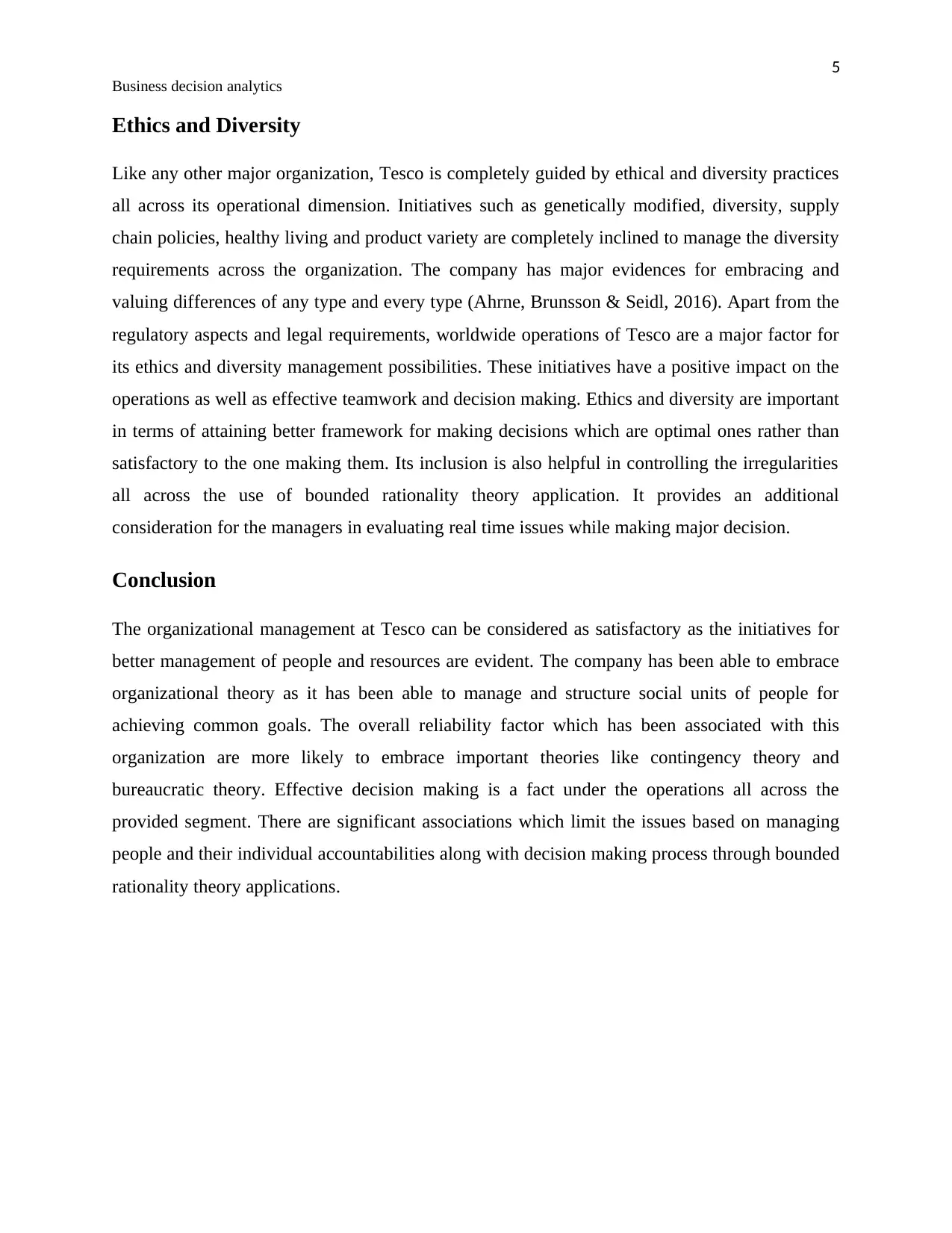
5
Business decision analytics
Ethics and Diversity
Like any other major organization, Tesco is completely guided by ethical and diversity practices
all across its operational dimension. Initiatives such as genetically modified, diversity, supply
chain policies, healthy living and product variety are completely inclined to manage the diversity
requirements across the organization. The company has major evidences for embracing and
valuing differences of any type and every type (Ahrne, Brunsson & Seidl, 2016). Apart from the
regulatory aspects and legal requirements, worldwide operations of Tesco are a major factor for
its ethics and diversity management possibilities. These initiatives have a positive impact on the
operations as well as effective teamwork and decision making. Ethics and diversity are important
in terms of attaining better framework for making decisions which are optimal ones rather than
satisfactory to the one making them. Its inclusion is also helpful in controlling the irregularities
all across the use of bounded rationality theory application. It provides an additional
consideration for the managers in evaluating real time issues while making major decision.
Conclusion
The organizational management at Tesco can be considered as satisfactory as the initiatives for
better management of people and resources are evident. The company has been able to embrace
organizational theory as it has been able to manage and structure social units of people for
achieving common goals. The overall reliability factor which has been associated with this
organization are more likely to embrace important theories like contingency theory and
bureaucratic theory. Effective decision making is a fact under the operations all across the
provided segment. There are significant associations which limit the issues based on managing
people and their individual accountabilities along with decision making process through bounded
rationality theory applications.
Business decision analytics
Ethics and Diversity
Like any other major organization, Tesco is completely guided by ethical and diversity practices
all across its operational dimension. Initiatives such as genetically modified, diversity, supply
chain policies, healthy living and product variety are completely inclined to manage the diversity
requirements across the organization. The company has major evidences for embracing and
valuing differences of any type and every type (Ahrne, Brunsson & Seidl, 2016). Apart from the
regulatory aspects and legal requirements, worldwide operations of Tesco are a major factor for
its ethics and diversity management possibilities. These initiatives have a positive impact on the
operations as well as effective teamwork and decision making. Ethics and diversity are important
in terms of attaining better framework for making decisions which are optimal ones rather than
satisfactory to the one making them. Its inclusion is also helpful in controlling the irregularities
all across the use of bounded rationality theory application. It provides an additional
consideration for the managers in evaluating real time issues while making major decision.
Conclusion
The organizational management at Tesco can be considered as satisfactory as the initiatives for
better management of people and resources are evident. The company has been able to embrace
organizational theory as it has been able to manage and structure social units of people for
achieving common goals. The overall reliability factor which has been associated with this
organization are more likely to embrace important theories like contingency theory and
bureaucratic theory. Effective decision making is a fact under the operations all across the
provided segment. There are significant associations which limit the issues based on managing
people and their individual accountabilities along with decision making process through bounded
rationality theory applications.
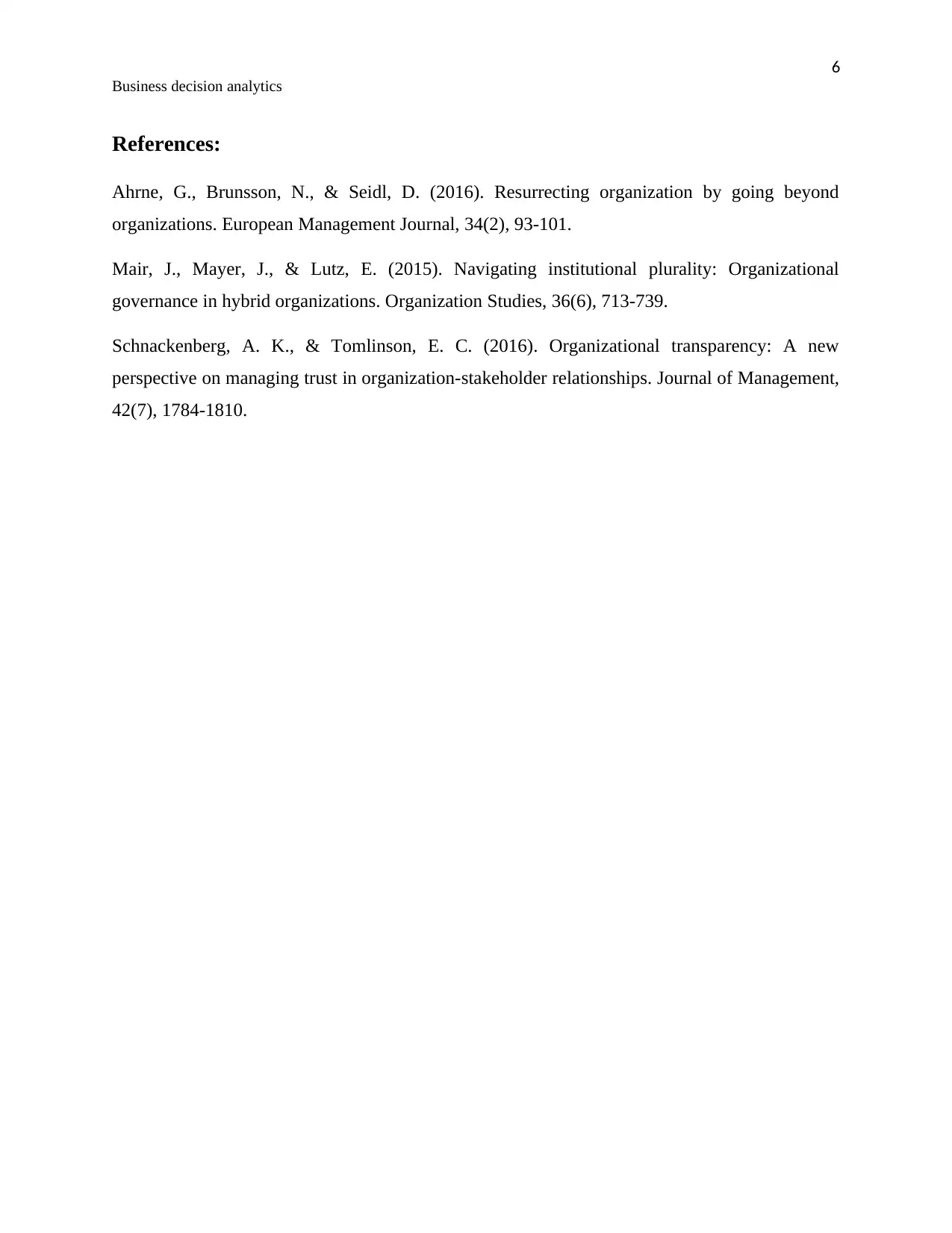
6
Business decision analytics
References:
Ahrne, G., Brunsson, N., & Seidl, D. (2016). Resurrecting organization by going beyond
organizations. European Management Journal, 34(2), 93-101.
Mair, J., Mayer, J., & Lutz, E. (2015). Navigating institutional plurality: Organizational
governance in hybrid organizations. Organization Studies, 36(6), 713-739.
Schnackenberg, A. K., & Tomlinson, E. C. (2016). Organizational transparency: A new
perspective on managing trust in organization-stakeholder relationships. Journal of Management,
42(7), 1784-1810.
Business decision analytics
References:
Ahrne, G., Brunsson, N., & Seidl, D. (2016). Resurrecting organization by going beyond
organizations. European Management Journal, 34(2), 93-101.
Mair, J., Mayer, J., & Lutz, E. (2015). Navigating institutional plurality: Organizational
governance in hybrid organizations. Organization Studies, 36(6), 713-739.
Schnackenberg, A. K., & Tomlinson, E. C. (2016). Organizational transparency: A new
perspective on managing trust in organization-stakeholder relationships. Journal of Management,
42(7), 1784-1810.
⊘ This is a preview!⊘
Do you want full access?
Subscribe today to unlock all pages.

Trusted by 1+ million students worldwide
1 out of 6
Related Documents
Your All-in-One AI-Powered Toolkit for Academic Success.
+13062052269
info@desklib.com
Available 24*7 on WhatsApp / Email
![[object Object]](/_next/static/media/star-bottom.7253800d.svg)
Unlock your academic potential
Copyright © 2020–2025 A2Z Services. All Rights Reserved. Developed and managed by ZUCOL.




